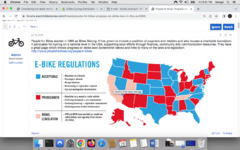Hello I am new to this site, just scrolling down the posts I was thinking about this very subject, I started out looking for the ordinances for my area here in seattle as I have been feeling the gap between regular bike riders and the reaction to ebikes. I wanted to be prepared for the eventual argument with one of these people who think they own the bike path and have the right to accost others who ride an ebike and even pedestrians if they are in "their" way. I ride to enjoy the ride I pedal when I feel like it, I ride more for pleasure than exercise and I ride safely, my bike will do 20mph on the straight long stretches which is plenty for a bike, I'm no panzy either, I pushed it plenty when I was younger and still like a speed rush now and then , 20mph is ok but plenty , but starts getting squirrely above that speed, the bike is not flimzy or light so its pretty stable at hi speed. But the reality is over 15-20 is just to fast for bike paths regardless if it is a regular bike or an ebike - Especially when there are pedestrians who rarely pay attention to staying on the right side and usually are wearing earpods and can't hear my bell so I have to slow down anyway to safely get around them and then there are little kids jumping around anyway, I can't really blame them to much as they are just out for a nice walk to, what really gets my goat is the anal spandex wearing psychos who have all there fancy fitness devices cruising as fast as they can go zipping past unaware pedestrians and other bikes constantly checking their pulse and speed thinking that they are the only people allowed on the path. spouting rules and laws when in fact they themselves are the most dangerous people out there, and these are the people whining that ebikes are unsafe. There does need to be some rules pertaining to the use of the bike trails as more people build faster bikes , the bottom line though is people just need to be considerate of others and be responsible while riding, seems simple but I see ta growing crowd out there especially the entitled younger crowd becoming more self centered and selfish and a lot of the " its all the other guys fault" attitude. this is why I will not ride on the road, there are so crazy people out there - why would I risk my life riding anywhere near cars just to make a point that I have the right to do so. It's illegal here to ride on the sidewalk but I do it anyway but I am respectful of pedestrians right of way in doing so , and stay as far from them as i can, its called common sense. I am babbling. but yes I very much agree a speed limit is reasonable , i've seen many near misses from speeders.
